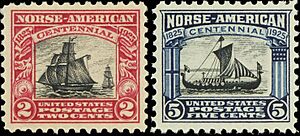Norse-American Centennial facts for kids
The Norse-American Centennial was a big celebration held at the Minnesota State Fair. It took place from June 6 to June 9, 1925.
Contents
What Was the Celebration About?
This event celebrated a very important moment in history. It marked 100 years since the Norwegian immigrant ship Restauration arrived in 1825. This ship's arrival is seen as the start of organized Norwegian-American immigration to the United States.
Many important people helped organize the Centennial. Gisle C. J. Bothne, a professor from the University of Minnesota, was the president of the celebration. Johan Andreas Holvik from Concordia College was the secretary. Knut Gjerset from Luther College was the director. Even famous author O. E. Rolvaag was on the advisory committee.
President Coolidge and Special Guests
The President of the United States at the time, Calvin Coolidge, attended the event. He spoke about how much Scandinavian-Americans had contributed to the country. He also mentioned Leif Erikson as the person who discovered America.
The celebration featured lots of music! Groups from Norwegian Lutheran colleges like St. Olaf College, Luther College, Augustana College, and Augsburg Seminary performed. There was also a special play, called a pageant. It told the story of Colonel Hans Christian Heg, a war hero. Colonel Heg was a Norwegian immigrant who led a brigade during the American Civil War.
Art and Women's Contributions
The Norse-American Centennial also had an art exhibit. It showed amazing works by many talented Norwegian-American artists. Some of these artists included Lars Jonson Haukaness, Karl Ouren, Svend Rasmussen Svendsen, Paul Fjelde, and Benjamin Blessum.
Women also played a big role in organizing the event. Mabel Johnson Leland was the State Chair of the Woman's Auxiliary, which was a special group of women helping with the celebration.
Special Commemorative Items
To mark this special occasion, the United States Postal Service created two unique commemorative stamps.
- The two-cent stamp showed what the ship Restauration might have looked like. This was based on a drawing of a similar ship.
- The five-cent stamp featured a picture of the Viking. This was a replica Viking ship that sailed all the way from Norway to Chicago for the Columbian Exposition of 1893.
The United States Congress also approved special Norse-American Centennial medals. The United States Mint made four different octagonal-shaped medals. Minnesota Congressman Ole J. Kvale helped make sure these medals were produced. Congress allowed 40,000 silver medals and 100 gold medals to be made at the Philadelphia Mint.
A Lasting Legacy
The excitement from the Centennial helped inspire the building of a memorial church. This church became The Norwegian Lutheran Memorial Church of Minneapolis, also known as Mindekirken. It is a Norwegian language Lutheran church that was officially opened on May 4, 1930.


